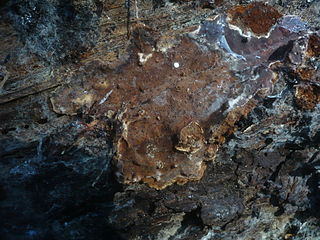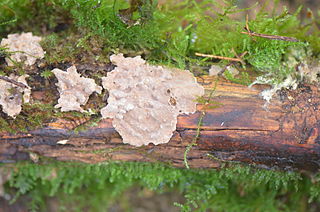Related Research Articles
Leadwood may refer to:

Frass refers loosely to the more or less solid excreta of insects, and to certain other related matter.

The Stereaceae are a family of corticioid fungi in the Russulales order. Species in the family have a widespread distribution, are lignicolous or terrestrial, and typically saprobic. According to the Dictionary of the Fungi, the family contains 22 genera and 125 species.

The Key West Tropical Forest & Botanical Garden is a frost-free arboretum and botanical garden containing a collection of trees, shrubs, and palms, including several "champion tree" specimens. It is located on Stock Island in the municipality of Key West, Florida, United States. It is open daily. There is a nominal fee for admission, with free admission for locals on the first Sunday of every month.
Black ironwood is a common name for several plants and may refer to:

Silver leaf is a fungal disease of trees caused by the fungal plant pathogen Chondrostereum purpureum. It attacks most species of the rose family Rosaceae, particularly the genus Prunus. The disease is progressive and often fatal. The common name is taken from the progressive silvering of leaves on affected branches. It is spread by airborne spores landing on freshly exposed sapwood. For this reason cherries and plums are pruned in summer, when spores are least likely to be present and when disease is visible. Silver Leaf can also happen on poming fruits like apples and pears. Plums are especially vulnerable.

Liguus is a genus of large tropical air-breathing land snails, more specifically arboreal or tree snails, terrestrial pulmonate gastropod mollusks in the family Orthalicidae.

Krugiodendron ferreum, commonly known as the black ironwood or leadwood, is a species of tree in the family Rhamnaceae. It is found in southern Florida, throughout the Caribbean and from southern Mexico to Honduras. Originally described by Martin Vahl, its specific epithet is the Latin adjective ferreus ("iron-like").
Forest pathology is the research of both biotic and abiotic maladies affecting the health of a forest ecosystem, primarily fungal pathogens and their insect vectors. It is a subfield of forestry and plant pathology.

The sirex woodwasp is a species of horntail, native to Europe, Asia, and northern Africa. Adults vary in length from 9 to 36 mm.

The Ibaliidae are a small family of the hymenopteran superfamily Cynipoidea. Ibaliidae differ from most of the cynipoids by the larvae being parasitoids on other wasp larvae in the group Siricidae. The Ibaliidae comprise three extant genera of fairly large wasps, with a total of 20 species, and is a sister group to the rest of the cynipoids except the small subfamily Austrocynipidae.
Agonum ferreum is a species of ground beetle from Platyninae subfamily, that can be found in the United States.

Eueana niveociliaria is a moth of the family Geometridae first described by Gottlieb August Wilhelm Herrich-Schäffer in 1870. It is found in the US state of Florida, as well as on the Bahamas, Cuba and Jamaica.

Amylostereum is the single genus in the fungal family Amylostereaceae. The genus currently comprises four saprotrophic and parasitic species, which live off living or dead wood. The Amylostereaceae cause white rot in the wood by disintegrating the tissue component lignin. They produce crust-like, partially wavy fruit bodies on the surface of infested trees, which are similar to those produced by Stereum species.

Amylostereum areolatum is a species of crust fungus. Originally called Thelephora areolata in 1828, it was given its current name by French mycologist Jacques Boidin in 1958.

Amylostereum chailletii is a species of crust fungus. It was originally described in 1822 as Thelephora chailletii by Christian Hendrik Persoon in 1822, and given its current name when it was moved into Amylostereum by Jacques Boidin in 1958. It causes a white rot, especially in spruce and fir species.

Amylostereum laevigatum is a species of crust fungus in the family Amylostereaceae. Originally named Thelephora laevigata by Elias Fries in 1828, it was given its current name when transferred to the genus Amylostereum by French mycologist Jacques Boidin in 1958.
Dichomeris condaliavorella is a moth in the family Gelechiidae. It was described by August Busck in 1900. It is found in North America, where it has been recorded from Florida.

Ibalia is a genus of ibaliid wasps in the family Ibaliidae. There are about 14 described species in Ibalia. All species are parasitoids of Siricidae species, which they seek out by detecting volatiles emitted by the fungi Siricidae larvae feed on, Amylostereum.
Urocerus japonicus, commonly known as the Japanese horntail, is a species of sawfly, native to southeastern Asia. Studies show that the dispersal distance of the female is higher than the male. The fungal species Amylostereum laevigatum had its first appearance in Japan via this sawfly.
References
- ↑ "Amylostereum ferreum (Berk. & M.A. Curtis) Boidin & Lanq. 1984". MycoBank. International Mycological Association. Retrieved 2012-05-31.